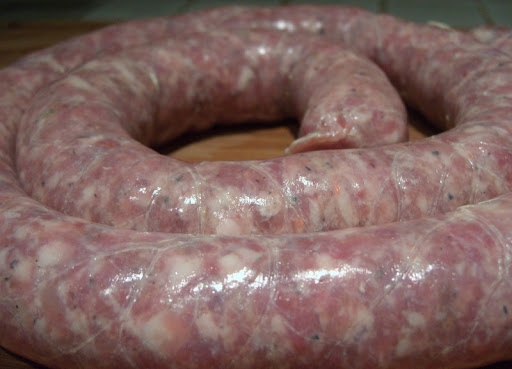Making Sausage

We have been making our own sausage for years now. It is easy to do and allows you to use whatever ingredients you want. We have used pork, turkey, and chicken and have gone all sorts of flavor directions - Mexican, Spanish, Thai. Our go-to staple, though, is the basic Italian sausage.
Sausage making starts with the meat. For Italian sausage, you want to use a cut of pork with high fat content. This can usually been done quite cheaply. This time, we used country-style pork ribs for a whopping $0.99 a pound.

Next, you will need some kind of meat grinder. We're really happy with the grinding attachment for our Kitchenaid mixer.

Once the meat is ground, it needs to be seasoned. Italian sausage is pretty simple. Fennel seed (whole and ground), fresh garlic and hot red chile flakes make up the flavor base. Salt and pepper give it a boost and a little dry white wine helps keep it moist. Using your hands, mix gently, but thoroughly. As Elise and Tom point out, make sure you fry up a little patty to taste for seasoning. Does it need salt? More heat?

It is important to chill your seasoned sausage meat in the fridge for at least two hours or overnight. This makes the fat more solid and less slippery to work with when stuffing and improves the final texture.
Once you your sausage meat is ready, it is time for casings. We use natural casings that we get from our local butcher. We use hog casings for regular sized sausage and sheep casings for smaller sausages (like breakfast links).

The casing comes packed in salt to preserve it. You'll probably only need 2 or 3 strands - the rest should be sealed tightly and stored in the refrigerator.

You need to rinse and hydrate them before use.

And then it is back to the Kitchenaid again. This time, the grinder is replaced with a sausage-stuffing tube.

Twist up the resulting mega-sausage into smaller ones, and you're done.

Once you have basic sausages like these mastered, there are all sorts of other kinds of sausages to try. A couple of our favorites:
- Smoked Andouille - We got hooked on Andouillle when visiting Louisiana. This is our version.
- Smoked Beef Sausages - Our recreation of the amazing beef sausages they make in Lockhart, Texas.
2 1/2 pounds pork shoulder (with plenty of fat)
2 teaspoons fennel seeds
2-3 garlic cloves, minced
1/3 cup dry white wine
1/2 teaspoon ground fennel seed
2 teaspoons red chile flakes
3 teaspoons kosher salt
2 teaspoons freshly ground black pepper
Cut meat into finger-shaped strips. Grind coarsely with a meat grinder. Chill 1 hour. Use your hands to thoroughly mix in the seasonings (use a light hand and work quickly to keep the fat from going mushy). Pinch off about a tablespoon of sausage and cook it in a small fry pan. Taste for seasoning - add additional chile or salt if required. Chill the sausage meat at least 2 hours or overnight.
Select 2 or 3 lengths of hog casings and place into a sink full of cool water. Hydrate for about 10 minutes, then scoop up the casings and replace the salty water with fresh water. Rinse the inside of each casing by holding the end open with two fingers and allow a thin stream of cool water to enter the casing and expand it. Empty each casing then repeat the rinse.
Feed the casing onto a sausage stuffer tube and stuff with cold sausage meat. Pack the sausages fairly full, but don't over-stuff. Twist the resulting sausage into links 4 to 5 inches long. Chill a couple hours before cutting apart into individual links. Freeze any sausages that won't be used within a couple of days.







I heard mostly negative reviews regarding the sausage stuffing tube, so I do not own one. I know Kitchen Aid improved the grinder with later versions, and I love it. Maybe the sausage stuffing tube has improved as well? Do you have any trouble with your sausage stuffing tube?
ReplyDeleteIf you highly recommend it, I will probably get one.
Great post! Very educational and great pics. I think I need to make some sausage.
Cheers
Matt
Hi Matt, We've never used anything but the Kitchen Aid attachment, so have nothing to compare it with. That said, it's pretty simple and fast to use, and I'm very happy with it.
ReplyDeleteThere have been a few times where we've encountered stuffing problems, however I've learned that it's usually a problem with my recipe or technique:
1) for any sausage, if the meat mixture is not cold enough, it slips in the plastic feeder resulting in a slow stuffing process.
2) if the sausage doesn't have enough fat, the meat mixture is more paste-like and won't feed into the tube well. Keeping things cold helps remedy this issue.
I think many problems stem from first-time sausage makers attempting to make "healthy, low-fat" sausages. It can be done, but the basic technique should be mastered with tried and true recipes first.
I definitely recommend doing homemade sausages and if you already have the Kitchen Aid, its stuffer attachment is a good way to go.
Good luck -- we look forward to hearing about the results!
Sherry
Thanks a ton!
ReplyDeleteI follow the same process, however I cut the meat,. mix the spices and wine and leav in a ziplock overnight in the fridge. I turn the bag over a few times. I alos add parmesan cheese to the mix.
ReplyDeleteI use the kitchen aid and have no issues. I would recommned putting the attachment, including the die in the freezer a hour before use as well.
Hi Baccala, Throwing all the attachment parts in the freezer before trying to stuff your sausage is a great tip. I think the worm would benefit most from this since it has a metal core. Thanks!
ReplyDeleteGreetings from Ocean Beach, San Diego! We buy our sausage casings from the same place, and we've been using the same KitchenAid attachment, including its stuffer tube. But the plastic pusher is awful, as it's a mite too small. Where did you get the wooden pusher you're showing in your second-to-last photo?
ReplyDeleteHi Andy, Nice to meet you, neighbor. :-)
ReplyDeleteOur wooden stomper came with our KitchenAid attachment set. At the time (several years ago), you could purchase the food grinder and sausage stuffer attachments in a single package, and the wooden pusher came with it. The KA grinder kit currently being sold on Amazon appears to include the wooden stomper, but that seems like an expensive way to purchase it if you already own the grinder!
The key to good sausage is the bind or the mix. If you do not mix the meat and fat well, the sausage will have a crumbly texture. This must be done cold or the meat will emulsify and turn into a hog dog style sausage.
ReplyDeleteAre you still purchasing your sheep casings from Iowa Meats? I get my sheep casings there but they've told me they don't carry the sheep which means I have to go to either Mona Lisa's (Downtown) or Tip Top (Carlsbad). Iowa Meats is way closer to my place.
ReplyDeleteHi Jered,
ReplyDeleteNo, had the same experience; Siesel's stopped selling them a while back. Most recently I purchased a big package online from Butcher & Packer. They were packed in liquid brine rather than salt so they were a little messy and smelly to work with initially, but they produced nice sausages. I re-salted the remainder and they seem to be storing well in the refrigerator.
It's nice to hear that Mona Lisa's and Tip Top sells them -- I didn't know that. Thanks!
Thanks Sherry! I just re-red my post and see I erred in saying I get my sheep casings at Iowa meats, I meant my hog casings, sorry for any confusion.
ReplyDeleteOh, funny! Yes, I get my hog casings from Siesel's too (same company as Iowa meats, but different location). I've only purchased the sheep casings online, however. Thanks for clarifying, Jered. :)
ReplyDelete